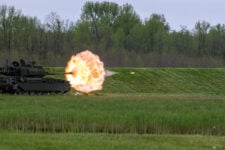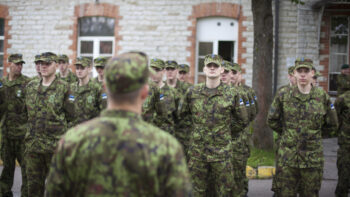
Coils of concertina wire line the perimeter at Transit Center at Manas, Kyrgyzstan, Dec. 12, 2013. (U.S. Air Force photo/Senior Airman George Goslin)
AUSA 2022 — The Pentagon’s third “sprint” of a relatively new effort aimed at addressing capability gaps and emerging technologies will be focused on base defense, and the Defense Department wants industry’s help, according to the official spearheading the effort.
Speaking with a small group of reporters at the annual Association of the US Army conference Monday, Heidi Shyu, undersecretary of defense for research and engineering, said her office is waiting to get fiscal 2023 funding for the Rapid Defense Experimentation Reserve (RDER), but meanwhile DoD is holding industry engagements as it plans the next experiment. The Pentagon requested $358 million for the effort in fiscal 2023.
“Until we get the FY23 money we can’t fund it, right?” Shyu said. “So this year, we had an industry day…in the July timeframe, [to] which almost like 500 people showed up. And it was very good and we’re getting additional white papers from them… So each one of these [sprints are] going to be staggered, but it doesn’t mean our doors closed to new ideas.
“I think it’s important to understand as long as we have funding, we’re always interested, whoever has a great idea that has a prototype you can bring to the table to demo,” she continued.
Shyu has said in the past she wants to hold two RDER “sprints” per year to allow industry to make changes or upgrade their prototypes. The first sprint was held last summer and the second sprint focused on the area of predictive logistics.
“The third sprint’s…about how do we protect the forward base,” Shyu said. “So that’s a scenario that we will wrap our experimentation around.”
The Pentagon has also seen some success with another effort Shyu is spearheading called the new Accelerate the Procurement and Fielding of Innovation Technologies (APFIT) pilot program, which was established earlier this year to bridge the dreaded “valley of death” where promising technologies fail to shift from the lab into actual operations, Shyu said.
In the first round of funding for APFIT, DoD allocated $100 million to 10 different program offices to procure technologies from vendors. Shyu mentioned that some of the technologies being developed right now include a night vision goggle and a conformable antenna. She added that the Pentagon is requesting another $100 million in FY23.
“I can tell you the companies are thrilled… All of these companies have a user that’s interested in, whether its special ops, whether its Army, Navy, Air Force, Space Force — there’s a user that’s interested in this particular technology,” Shyu said. “So what we’ve been able to do is utilize that money to help these 10 companies to accelerate getting the capability in the hands of the warfighter two years earlier.”























